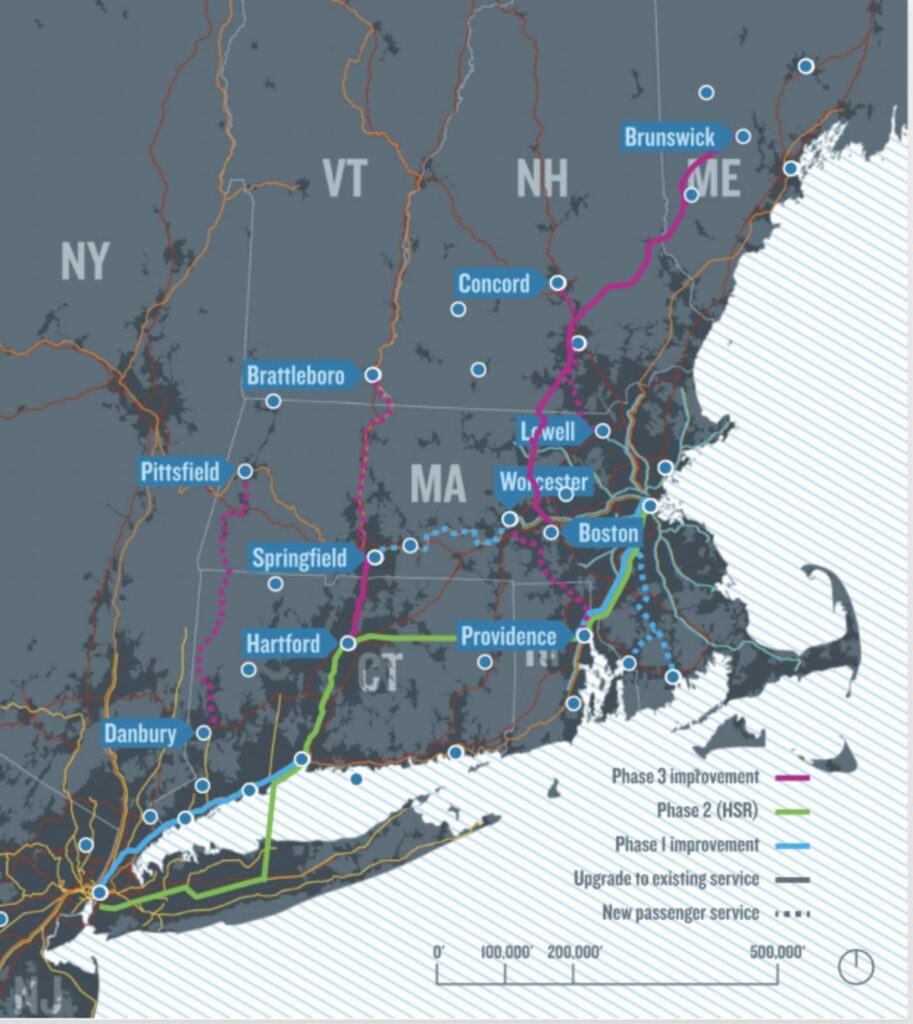New Hampshire U.S. Reps. Annie Kuster and Chris Pappas are backing a $105 billion high-speed rail project for New England, similar to the high-profile – and highly controversial bullet train project currently under construction in California.
A group of 23 members of Congress from the Northeast signed a letter of support last week for the North Atlantic Rail (NAR) project. According to its backers, it would deliver passengers from Boston to New York City in 100 minutes on trains traveling 200 mph. It would also connect smaller communities with lower population density like Manchester, Concord, and Nashua as well as Brunswick, Maine, into “a single market for labor, capital, and ideas,” according to the project’s website.
“North Atlantic Rail will provide frequent and reliable service between New York and Boston while building out regional rail networks serving mid-sized cities in New England and New York.”
Fans of expanded rail service in the Granite State point to a 2019 St. Anselm College poll finding 75 percent of respondents said they support the idea. But that poll made no mention of the costs to taxpayers — which are high.
For example, the $105 billion NAR pricetag is, according to Democrat Sen. Richard Blumenthal of Connecticut, almost certainly a lowball figure. That was certainly true of the Big Dig. Proponents originally said it could be built for around $3 billion. The price tag when the final section of tunnel was opened was $23 billion.
And the Big Dig was engineering child’s play compared to the NAR project Kuster and Pappas are backing. It would involve tunneling beneath the Big Dig, as well as a tunnel from New York City’s Pennsylvania Station under the East River, plus a 16-mile tunnel under the Long Island Sound.
By comparison, the California bullet train is being built above ground and in largely rural areas. In 2008, taxpayers were asked to support a $10 billion referendum for a project that promised to get riders from San Francisco to L.A. in just over two and a half hours and cost $30 billion.
Today, the proposed rail line is half as long, it won’t reach either San Francisco or Los Angeles, and the current cost is approaching $100 billion — and climbing.
Now imagine that project, not through rural deserts, but through miles of tunnels built beneath the most densely-populated part of America.

COURTESY: North America Rail
Even if Kuster and Pappas get their $105 billion, critics of expanded passenger rail service wonder what it will accomplish? Getting from Boston to New York in an hour and a half is about the same as flying the shuttle. And how many train tickets from Concord to Boston — much less Concord to Worcester, Mass. — will be sold every day?
Neither Kuster nor Pappas would answer questions from NHJournal about their support for the project.
High-speed rail advocates make the “if you built it, they will ride” argument, but they aren’t doing it now. As the Boston-based Pioneer Institute pointed out, “MBTA commuter rail ridership declined from 36.13 million in 2012 to 32.14 million in 2018, an 11 percent drop over six years.” And that was before COVID-19 and concerns about social distancing. Commuter rail ridership fell more than 65 percent during the pandemic.
Passenger rail already needs massive taxpayer funding to keep ticket costs competitive, and that’s for rail systems like Amtrak that are far less expensive than the NAR proposal. Despite claims Amtrak is profitable, Randal O’Toole of the Cato Institute notes that when you account for the revenues from state subidies, Amtrak lost more tham $1 billion in 2019.
Imagine the losses on a system that costs more than $100 billion to build and is counting on ticket sales in Nashua, N.H. and Brunswick, Me.
President Joe Biden has talked about pouring $80 billion into the current systems and Amtrak is asking for $75 billion to upgrade its current service. So there simply may not be the money left for the NAR plan. But does expanding a fixed-point transportation system make sense for the American economy of the future?
As Andrew Cline, president of the Josiah Bartlett Center for Public Policy wrote: “Rail is a 19th-century technology that is ill-suited to solving 21st-century transportation and environmental issues. The way forward is through innovation. Electric vehicles and autonomous vehicles will get people where they need to go while reducing greenhouse gas emissions and turning commute time into productive work time. They are far more versatile than trains and will serve people’s travel needs better.”





